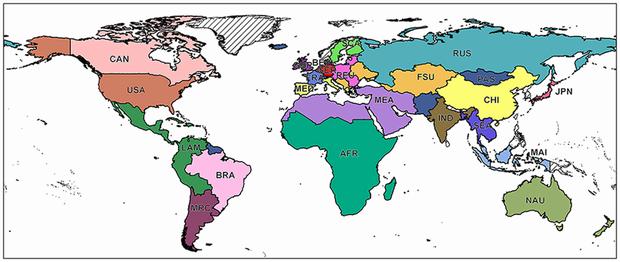Over half of the Earth's accessible agricultural land is already under cultivation because ecological factors such as climate, soil quality, water supply and topography determined the suitability of land for agriculture when people had to just find the best spots.
There are various knobs turning for the future of food. Science has made it possible for food to be grown with less environmental strain in more and more areas but climate change may impact global agriculture.
Some regions may actually benefit from a game-changing event, of course. In a new study, researchers focused on the probable impact of climate change on the supply of land suitable for the cultivation of the 16 major food and energy crops worldwide, including staples such as maize, rice, soybeans and wheat. They simulated the impact of climate change on agricultural production over the course of the 21st century and found that two-thirds of all land potentially suitable for agricultural use is already under cultivation.

Map of the 23 world regions: AFR (Sub Saharan Africa), ANZ (Australia, New Zealand), BEN (Belgium, Netherlands, Luxemburg), BRA (Brazil), CAN (Canada), CHN (China), FRA (France), FSU (Rest of Former Soviet Union and Rest of Europe), GBR (Great Britain), GER (Germany), IND (India), JPN (Japan), LAM (Rest of Latin America), MAI (Malaysia, Indonesia), MEA (Middle East, North Africa), MED (Italy, Spain, Portugal, Greece, Malta, Cyprus), PAC (Paraguay, Argentina, Chile, Uruguay), ROW (Rest of the World), REU (Austria, Estonia, Latvia, Lithuania, Poland, Hungary, Slovakia, Slovenia, Czech Republic, Romania, Bulgaria), RUS (Russia), SCA (Finland, Denmark, Sweden), SEA (Cambodia, Laos, Thailand, Vietnam, Myanmar, Bangladesh), USA (United States of America).
doi:10.1371/journal.pone.0107522
Climate change may expand suitable cropland, particularly in the Northern high latitudes, but tropical regions may becoming decreasingly suitable.
The results indicate that climate change may expand the supply of cropland in the high latitudes of the Northern hemisphere, including Canada, Russia, China, over the next 100 years. However, in the absence of adaptation measures such as increased irrigation, the simulation projects a significant loss of suitable agricultural land in Mediterranean regions and in parts of Sub-Saharan Africa.
The land suitable for agricultural would be about 54 million km2 – and of this, 91% is already under cultivation.
"Much of the additional area is, however, at best only moderately suited to agricultural use, so the proportion of highly fertile land used for crop production will decrease," says Florian Zabel from Ludwig Maximilians University, Germany and colleagues.
Moreover, in the tropical regions of Brazil, Asia and Central Africa, climate change will significantly reduce the chance of obtaining multiple harvests per year.
"In the context of current projections, which predict that the demand for food will double by the year 2050 as the result of population increase, our results are quite alarming. In addition, one must consider the prospect of increased pressure on land resources for the cultivation of forage crops and animal feed owing to rising demand for meat, and the expansion of land use for the production of bioenergy," says Zabel.





Comments